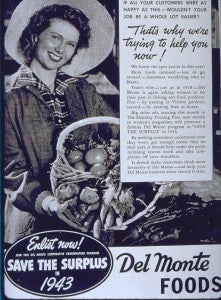Today we have new commentary on advertisements from Katharine Kipp, graduate student in the History department at U.C. Davis
Advertisements are an excellent way to engage students in historical thinking as they provide an opportunity for students to identify historical events and ideas and analyze their meaning. In particular, ads are a great way to discuss cultural norms. One example from the Marchand Collection, is the 1946 advertisement for McCall’s Magazine featuring a mother reading Lives of Great Men to her adolescent son all the while the father, perhaps, perches high above them both. The caption reads, “HE shapes the mind” while “SHE shapes the character.” It echoes perfectly the 1940s and 1950s reinforcement of traditional gender roles that followed the turmoil of World War II and reflects the anxieties of the conflict between the US and Soviet Union. Stability was paramount during the Cold War. Both sides vied for control of newly emerging free nations and sought to present their path—communism or capitalism—as the clear choice for rule. To ensure stability at home during this tenuous time, a culture of consensus or conformity asked the population to agree on traditional gender roles for men and women that celebrated women’s domesticity. This ‘domestic containment’ confined women to the home where they were charged with creating a safe haven for the family. Linking national security and traditional gender roles, the United States sought safety both abroad and at home. Men and women worked together for a singular purpose. As the ad states, “Man and woman are in partnership—each with an essentially different role to play in preparing an oncoming generation for the business of living.” Domestic containment of the 1940s-1950s did not necessarily relegate women to a subservient position to their husbands. Rather, it attempted to create a partnership–women as experts of the domestic realm, men as the authority of the public sphere.
In addition to domestic containment, the ad addresses the presence of specialist and self-help literature in the 1940s and 1950s. The ad argues, “McCall’s is a magazine women really live by—and for that reason, a potent medium for moving ideas into women’s minds,” a sentiment shared by other advertisers and writers of popular help books of the era. Magazines such as McCall’s and books such as Dr. Benjamin Spock’s Baby and Child Care (1946) found a ready and willing audience of women searching for help in ‘professionalizing’ their role as wife and mother. McCall’s Magazine guided “Women’s Thinking” as it served “her specialized interests in homemaking and family life” just as Dr. Spock appealed to women’s interest in child rearing.
Finally, the ad is also useful for reviewing important roles for women throughout US history. Examples include republican motherhood, the cult of domesticity, and separate spheres. Revolutionary ideas of republican motherhood are echoed here, as mothers (the purveyors of morality and responsibility) were tasked with creating good Republican citizens. It also harks back to the cult of domesticity and separate spheres of the middle nineteenth century that gave women power and influence over the private sphere or the home. Linking ideas across time helps students see patterns in history and aids information retention.
For more from Katharine Kipp, see Enlisting the Citizen Consumer in World War II

